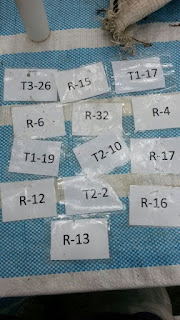From the first twenty colonies, we had gradually increased the number to one hundred and thirty over the next two years. It wasn't easy as we had to plant a lot of flowers and trees as the farm is located amongst palm oil plantations which do not provide a source of nectar, resin, pollen and other elements needed to sustain the bees.
Cultured stingless bees in the country, mainly in the northern and east coast states of peninsula Malaysia were invaded by two different kinds of pests simultaneously: the black soldier fly (Hermetia illucens) and the sap beetle (Haptoncus luteolus). Some farms had lost hundreds of logs. Bilut Valley Bee Farm was not spared by this ravaging infestation that we believe, was an after effect of the El Nino phenomenon. Not as many as others but a great loss to us, nevertheless.
The situation was reported by Sinar Harian following an interview with Assoc. Prof. Dr. Shamsul Bahri Abd Razak from Universiti Malaysia Terengganu. Read the report here.
 | |
| All I could do was watch, mostly Aiman's hard work on the toppings, go to ash |
 |
| I was so proud of Marzia; despite the pressing situation, she had the foresight to collect a sample of the honey from the infected logs that could be used for analysis. |
 |
| I had insisted Aiman saw the logs before burning to ensure no bees, especially a queen bee was left behind. |
 |
| The casualties. |
 |
| Firdaus - Dr. Shamsul's trusted and able research assistant. |
Thanks to each and everyone of them, I rebounded rather quickly from the calamity. There was a point when I had started to think if I had made the right decision going into meliponiculture. But I spotted a request to visit the farm by a friend of Aiman on our Facebook wall. This stopped me from thinking that way, and I knew it was a Sign from the Divine. Nik Saufi had visited the farm twice before, and this would be his third visit...because he simply loved it there. And so did many others. So many love the honey, too. I couldn't disappoint them all.
 |
| Najib - an extreme enthusiast of meliponines appointed by UMT to be a part of their research team. |
"Verily, along every hardship is relief."
I had just only been enlightened about these ayah belonging to Surah Insyiroh a few days before the incident. It had always been simply translated to me that relief came with hardship. But it had not been highlighted that lots of blessings come down within and during the hardship. I now bear witness to that; I was put in a vulnerable position but I am blessed with so many things and people, family who give love and support, and friends who gave a splendid show of camaraderie and esprit-de-corps.
The Rahmah (compassion) and blessings from Allah surpasses, reigns over everything.
This was my Ramadhan, one that was overflowing with blessings as had been promised by Allah swt, and one that I would not forget for I guess, a very long, long time.
Written by Aniza Zain Ahmed for my family members namely my beloved husband Ahmad Cendana who remained so cool while giving very rational advice which immediately gave me immense strength while I was shaken and frantic. My children Aiman Mazlan and Marzia Mazlan who were calm, collected and so professional and took over handling the situation when their mom was distraught, my sisters Datin Aimi Zain Ahmed and Fauziah Shariff who stood solidly by us.
Also for the Kelulut Warriors Assoc. Prof. Dr. Shamsul Bahri Abdul Razak, Mohammad Firdaus bin Sulaiman, "Supermokh" Mokhtar Ishak, Hj. Mohd Najib Rais Hj Mohd Noordin (UMT Kelulut researchers), Puan Nur Hafizah Sharudin, Puan Hazrina Rashid (Perak DOA), veteren stingless beekeeper Tuan Rosman Mohd Isa, Mat Khairil Matkentoi and Assoc. Prof. Dr. Nurazura Adam (UPM).
 |
| Matkentoi, a man of a man of all trades. He had joined the response team on his own accord. |
.
















































